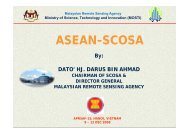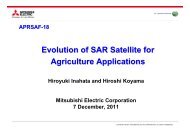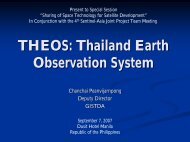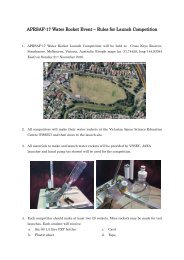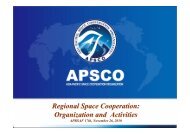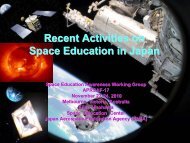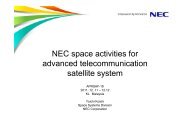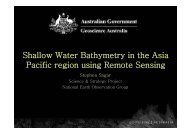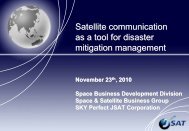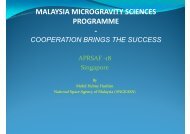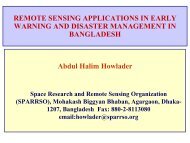University of Tokyo CubeSat Project CRITICAL DESIGN ... - APRSAF
University of Tokyo CubeSat Project CRITICAL DESIGN ... - APRSAF
University of Tokyo CubeSat Project CRITICAL DESIGN ... - APRSAF
You also want an ePaper? Increase the reach of your titles
YUMPU automatically turns print PDFs into web optimized ePapers that Google loves.
CanSat & Rocket Experiment(‘99~)<br />
UNITEC-1 ハイブリッド<br />
’10 Venus<br />
ロケット<br />
MEXT’s Program Called<br />
“UNIFORM”<br />
Univ.<strong>of</strong> <strong>Tokyo</strong> Kanenori Ishibashi, Shinichi Nakasuka<br />
Wakayama Univ. Hiroaki Akiyama<br />
PRISM ‘09<br />
<strong>CubeSat</strong> 03,05<br />
Nano-JASMINE ‘11
Contents <strong>of</strong> Presentation<br />
• Overview <strong>of</strong> Hands-on Student Satellite<br />
Development Activities in Japan<br />
• Significance <strong>of</strong> <strong>University</strong> micro/nano/pico-satellite<br />
projects<br />
• Training through CanSat program<br />
• First access to space: Cubesat and nano-satellites<br />
• Follow-on practical satellite projects<br />
• UNISEC (<strong>University</strong> Space Engineering Consortium)<br />
• UNIFORM Program<br />
• Objectives<br />
• Structure and contents<br />
• Schedule<br />
• Cooperation with STAR program
Educational Significances <strong>of</strong><br />
Micro/Nano/Pico-Satellite <strong>Project</strong>s<br />
• Practical Training <strong>of</strong> Whole Cycle <strong>of</strong> Space <strong>Project</strong><br />
• Mission conceptualization, satellite design, fabrication,<br />
ground test, modification, launch and operation<br />
• Know what is important and what is not.<br />
• Importance for Engineering Education<br />
• Synthesis (not Analysis) <strong>of</strong> an really working system<br />
• Feedbacks from the real world to evaluate design, test, etc.<br />
• Learning from failures<br />
• Education <strong>of</strong> <strong>Project</strong> Management<br />
• Four Managements: “Time, human resource, cost and risk”<br />
• Team work, conflict resolution, discussion, documentation<br />
• International cooperation, negotiation, mutual understanding<br />
• Lead to higher level space activities and industry
Example <strong>of</strong> CanSats<br />
1999 - now
ARLISS (A Rocket Launch for<br />
International Student Satellites)<br />
- Annual suborbital launch experiment -<br />
More than 500 students have been trained in CANSAT<br />
• ARLISS 1999:Sept. 11 (Japan:2, USA:2)<br />
• Univ.<strong>of</strong> <strong>Tokyo</strong>, Titech, Arizona State, etc.<br />
• ARLISS 2000: July 28-29 (Japan:4, USA:3)<br />
• ARLISS 2001: August 24-25 (Japan:5, USA:2)<br />
• ARLISS 2002: August 2-3 (Japan:6, USA:3)<br />
• ARLISS 2003: Sept.26-27 (Japan:6, USA:3)<br />
• ARLISS 2004: Sept.24-25 (Japan:6, USA:3)<br />
• ARLISS 2005: Sept.21-23 (Japan:7, USA:3)<br />
• ARLISS 2006 Sept.20-22 (Japan:8 USA:3 Europe:1)<br />
• ARLISS 2007 Sept.12-15 (Japan:10 USA:3 Korea:1)<br />
• ARLISS 2008 Sept.15-20: 10 th Memorial ARLISS !<br />
• ARLISS 2009 Sept.15-19 (Japan:12 USA:3 Korea:1)<br />
• ARLISS 2010 Sept.13-17 (Japan:13 USA:2 Korea:1)
Access to Real Space: <strong>CubeSat</strong> Emerged<br />
Success <strong>of</strong> <strong>CubeSat</strong>(1kg)by Univ.<br />
<strong>Tokyo</strong> and Titech(2003.6.30)<br />
• <strong>University</strong> level budget<br />
• Development within 2 years<br />
• Life time > 7 years<br />
• Ground operations, frequency<br />
acquisitions, launch opportunity<br />
search processed by ourselves<br />
• Higher level satellites(CUTE-1.7、<br />
PRISM、NJ, SPRITE-sat)<br />
<strong>CubeSat</strong> XI-IV & XI-V<br />
Russian<br />
Launch<br />
1~50kg (Nano/pico-sat): Starting<br />
from education, moving to practical<br />
utilizations
Photos taken by <strong>CubeSat</strong> “XI-IV” for 7 years
UNISEC (UNIversity Space<br />
Engineering Consortium)<br />
• Founded in 2002, became NPO in 2003<br />
• 47 laboratories from 38 universities: > 500 students<br />
• 168 individual and company supporting members<br />
• UNISEC Missions:<br />
• Education and human resource training for space<br />
development/utilization<br />
• Innovative space technology “seeds” development<br />
• Activities to be Supported:<br />
• Micro/Nano/Pico satellites, Ground station network<br />
• Hybrid rockets, study on space strategic plan<br />
• Workshop, joint experiment, etc. http://www.unisec.jp
<strong>University</strong> <strong>of</strong> <strong>Tokyo</strong> Nakasuka Lab. (ISSL)<br />
Roadmap <strong>of</strong> Nano-satellite Development<br />
2003 04 05 06 07 08 09 10 11<br />
<strong>CubeSat</strong> XI-IV<br />
(ROCKOT) ’03/6<br />
PRISM(Remotesensing)’09/1<br />
(H-IIA)<br />
30m ground resolution<br />
Space top-science<br />
educational<br />
4km ground<br />
resolution<br />
<strong>CubeSat</strong> XI-V<br />
(COSMOS) ’05/10<br />
NANO-JASMINE<br />
(astrometry) ’11<br />
UNITEC-1<br />
(H-IIA) ’10/5<br />
Deep space<br />
Hodoyoshi Sat-1<br />
(remote sensing)<br />
Development<br />
launch
Remote sensing PRISM “Hitomi”<br />
○size:8 kg 20cm×20cm×40cm<br />
year satellite resolution wright<br />
1999 UoSat-12<br />
10m (pan)<br />
32 (color)<br />
312kg<br />
2002 AISat 32 90<br />
2005 TopSat 2.5 110<br />
2009.1.23 PRISM 20~30 8.5<br />
1/23/’09 H-IIA<br />
piggyback launch<br />
-Extensible, refraction optics<br />
-OBC、bus, comm system, attitude control<br />
system upgraded<br />
- Bus standardization<br />
1, 伸 展 前 2, 伸 展 中 3, 伸 展 完 了 !!
Cloud image<br />
Sea coast <strong>of</strong> Mexico
Nano-JASMINE<br />
Astrometry satellite developed in<br />
collaboration with National<br />
Astronomical Observatory <strong>of</strong> Japan<br />
size<br />
50[cmcubic<br />
weight 30[kg](body)<br />
+11[kg](PAF)<br />
Attitude control 3-axis<br />
Comm. speed S-band 100[kbps]<br />
Mission life 2[year]<br />
Same performance with ’89 HIPPARCOS<br />
- Attitude stability (
Venture Business<br />
Using Nano-satellites<br />
2008.8.8 Foundation <strong>of</strong> venture<br />
business “AXELSPACE”<br />
- Standard nano-satellite bus for<br />
various missions<br />
- Satellite for “Weather News Co.”<br />
2011 launch<br />
PAF, Comm.<br />
Module and Star<br />
sensor<br />
http://axelspace.com
New Governmental <strong>Project</strong> for Nano-satellites (2010-13)<br />
Aiming for New paradigm<br />
<strong>of</strong> Space Utilization based<br />
on Nano-satellites<br />
1New reliability concept<br />
- “Reasonably reliable<br />
systems engineering”<br />
2Advanced technologies<br />
- new idea with “different<br />
way <strong>of</strong> realization” for<br />
each function<br />
- new architecture for<br />
nano-satellites<br />
3Process Innovation<br />
- Standardization to reduce<br />
cost/development time<br />
- Test process innovation<br />
4All Japan Consortium<br />
- Universities/Small Industries<br />
[ 通 Communication<br />
信 系 ] 静 止 軌 道 に 光 中<br />
継 衛 subsystem:<br />
星 を 想 定 した 宇 宙 - 宇<br />
宙 high 間 の performance<br />
汎 用 可 動 式 光 通 信<br />
機<br />
RF の 搭<br />
to 載<br />
optical (5 年 間<br />
link<br />
で 基 礎 実<br />
証 。 目 標 30Mbpsの 可 能 性<br />
を 確 認 ⇒ 将 来 は 軌 道 上 実<br />
証 実 験 )<br />
Optical [ 光 学 系 subsystem:<br />
]( 屈 折 式 ないし 反 射 式 )<br />
in-orbit すばる 望 compensation, 遠 鏡 などで 利 用 されてい etc to<br />
る 補 償 光 学 系 の 概 念 を、 位 相 変 調<br />
aim 素 子<br />
for を 利<br />
2m 用 して<br />
(final) 超 小<br />
to 型<br />
5m 衛 星<br />
(initial)<br />
搭 載 が<br />
ground 可 能 になるサイズにする resolution<br />
手 法 等 。<br />
( 目 標 : 分 解 能 5m= 従 来 の200kg 衛<br />
星 の 能 力 ⇒ 将 来 は2m 目 指 す)<br />
Optical 光 ビームbeam<br />
Deployable<br />
[ 伸 展 展 開 機 構 ]<br />
system:<br />
小 さな 衛 星 を 大<br />
concept/material<br />
きく 使 う。 機<br />
構 ・ 素 材 開 発<br />
Attitude<br />
[ 姿 勢 制 御 系 ]<br />
control<br />
目 標 : 安 定 度 10<br />
subsystem:<br />
秒 、 制 御 精 度 30<br />
1 秒 arcmin<br />
⇒ 将 来 は 安 定<br />
度 3 秒 、 制 御 精 度<br />
control<br />
10 秒 , 地 上 の 試 験<br />
accuracy<br />
技 術 もあわせて<br />
Structure/<br />
Thermal<br />
[ 構 造 ・ 材 料 ・ 熱 ]<br />
subsystem:<br />
モジュール 性 が<br />
easy 高 く、 設 to<br />
計 ・ 製 造<br />
develop が 容 易 な 構 and<br />
造 、<br />
analyze<br />
軽 量 高 強 度 材 料 、<br />
熱 制 御 素 材<br />
C&DH [ 機 上 コンピュータおよびバス]<br />
subsystem:<br />
耐 radiation 放 射 線 性 tolerant に 優 れた high<br />
半 導 体 お<br />
performance よびFPGAを 利 processor 用 ( 目 標 : and<br />
data 20MIPS、 link<br />
放 射 線 試 験 不 要 、 高<br />
速 衛 星 内 通 信
UNIFORM Program
UNIFORM (UNiversity International<br />
FOrmation Mission) as a new<br />
scheme <strong>of</strong> International Community<br />
• Each country develops one microsatellite<br />
(< 50kg)<br />
• To be operated in constellation manner<br />
• Standardization <strong>of</strong> bus/component<br />
• Training <strong>of</strong> satellite development is<br />
supported by Japanese Universities<br />
• Equipment cost partially supported by<br />
MEXT (under study)<br />
• Ground Station Network<br />
• Low-cost GS is developed to realize<br />
one GS in each country (S/X-band)<br />
• Missions<br />
• Common mission + individual mission<br />
• Common mission will be determined by<br />
discussions within community
Special Features <strong>of</strong> UNIFORM<br />
• Not only education but also practical and<br />
sustainable utilization is targeted:<br />
ex) Environment monitoring (forest, CO 2<br />
, sea …….)<br />
ex) Space science, technology demonstration<br />
ex) Business use……………….etc.<br />
with hyper-spectral camera, special sensors, etc.<br />
• Data acquisition, pre-processing and archive<br />
for real utilization should also be considered:<br />
• Constellation realizes short revisit interval and semireal<br />
time data acquisition upon request<br />
• Internet connection <strong>of</strong> GS and data archive<br />
• Mission (how to use the data) is important !
Organization (Initial phase 2010~11)<br />
UNIFORM Community<br />
UNIFORM Team Japan<br />
Wakayama Univ., Univ. <strong>of</strong><br />
<strong>Tokyo</strong>, NESTRA, <strong>Tokyo</strong> Univ. <strong>of</strong><br />
Sci, <strong>Tokyo</strong> Tech, Tohoku Univ.,<br />
<strong>Tokyo</strong> Met Univ., et.al<br />
Independent<br />
participation<br />
MicroSTAR<br />
Participants<br />
Take place in Japan<br />
Educational<br />
support<br />
Participants from<br />
More Countries<br />
Ground<br />
Station<br />
Data<br />
Archive<br />
Framework<br />
Develop<br />
Micro-sats<br />
Joint study on<br />
constellation mission
Schedule<br />
2010<br />
Initial phase<br />
2011.4-<br />
2012.4-<br />
Develop<br />
Low-cost GS<br />
GS Network<br />
Operation (Test)<br />
Starting today, please join !<br />
From April 2011<br />
Constellation<br />
Mission Design<br />
Data Archive<br />
Design<br />
Individual<br />
Mission Design<br />
Satellite<br />
Base Design<br />
Actual Development<br />
UNIFORM-1<br />
&<br />
UNIFORM-2<br />
2013.4-<br />
2014.4-<br />
GS Network<br />
Implementation<br />
& Operation<br />
Individual<br />
Mission Design<br />
Launch<br />
UNIFORM-3<br />
&<br />
UNIFORM-4
Cooperation with STAR Program<br />
Back ground<br />
• STAR program has been lead by JAXA to develop a micro-satellite<br />
by international collaboration especially in Asian region.<br />
• UNIFORM has recently been selected as a new MEXT program,<br />
aiming for development <strong>of</strong> constellation <strong>of</strong> micro-satellite by<br />
international collaboration. The idea <strong>of</strong> the program is partly<br />
overlapped with MicroSTAR concept.<br />
Strategy <strong>of</strong> Cooperation<br />
• STAR program participants will join UNIFORMsat#1 development<br />
within fiscal 2011 year.<br />
• UNIFORM will design a less-than-50kg class satellite on its own<br />
concept, but will refer to the result <strong>of</strong> conceptual design <strong>of</strong><br />
MicroSTAR if appropriate.<br />
If you are interested in UNIFORM Program<br />
• Please contact JAXA representative <strong>of</strong> STAR program if you are<br />
already involved in STAR, or directly contact Wakayama <strong>University</strong><br />
at: uniform_info@crea.wakayama-u.ac.jp
Background <strong>of</strong> the <strong>Project</strong><br />
GDP Growth<br />
• Saturated situation in the<br />
economy.<br />
• The future is not so optimistic.<br />
• We need people with new<br />
way <strong>of</strong> thinking!<br />
• Space education is one <strong>of</strong> the<br />
good opportunities to create<br />
such people.<br />
“Lost 10 years”<br />
We will probably loose another 10 years.<br />
And unfortunately, more 10 years might be<br />
lost.
Possible New Field in the Space Industry<br />
World Salas <strong>of</strong> Space Industry<br />
80 billion$<br />
Others<br />
Communications<br />
broadcastings<br />
World GPS Receiver Volume<br />
14million<br />
Asia<br />
Europe<br />
U.S.<br />
Japan<br />
• The space industry has become a part <strong>of</strong> social infrastructure:<br />
• Very active and attractive market because it is growing 14% annually.<br />
• GPS-related industries are growing with much higher speed.<br />
<br />
BUT most <strong>of</strong> them are dominated by a few fixed major players.<br />
Tips for us to be successful in the industry as miniaturized satellite player:<br />
“Semi-Real Time Data Acquisition”<br />
= Micro Satellite Constellation Mission
Organization (Initial phase 2010~11)<br />
UNIFORM Community<br />
UNIFORM Team Japan<br />
Wakayama Univ., Univ. <strong>of</strong><br />
<strong>Tokyo</strong>, NESTRA, <strong>Tokyo</strong> Univ. <strong>of</strong><br />
Sci, <strong>Tokyo</strong> Tech, Tohoku Univ.,<br />
<strong>Tokyo</strong> Met Univ., et.al<br />
Independent<br />
participation<br />
MicroSTAR<br />
Participants<br />
Take place in Japan<br />
Educational<br />
support<br />
Participants from<br />
More Countries<br />
Ground<br />
Station<br />
Data<br />
Archive<br />
Framework<br />
Develop<br />
Micro-sats<br />
Joint study on<br />
constellation mission
Any Questions
Additional Information
7 Nano/Pico-Satellites developed and<br />
launched by Japanese universities (2003-08)<br />
(r: Russia)<br />
<strong>University</strong><br />
<strong>University</strong> <strong>of</strong><br />
<strong>Tokyo</strong><br />
Name <strong>of</strong><br />
Satellite<br />
XI-IV<br />
XI-V<br />
Year Launcher Outlook<br />
2003 ROCKOT(r)<br />
2005 COSMOS(r)<br />
<strong>Tokyo</strong><br />
Institute <strong>of</strong><br />
Technology<br />
Hokkaido<br />
Institute <strong>of</strong><br />
Technology<br />
Nihon<br />
<strong>University</strong><br />
CUTE-1<br />
C-1.7+APD<br />
C-1.7+APDII<br />
2003<br />
2006<br />
2008<br />
ROCKOT(r)<br />
M-V(Japan)<br />
PSLV (India)<br />
HITSAT 2006 M-V(Japan)<br />
SEEDS 2008 PSLV(India)
6 Universities launched Micro/Nano/Pico<br />
Satellites on H-IIA Piggyback in Jan, 2009<br />
Tohoku Univ.<br />
SPRITE-SAT<br />
Univ.<strong>of</strong> <strong>Tokyo</strong><br />
PRISM<br />
<strong>Tokyo</strong> Metro.<br />
College <strong>of</strong><br />
Aeronautics<br />
KKS-1<br />
Subsystem Support<br />
-Osaka Prefect. Univ.<br />
SOHLA-1<br />
-Tokai <strong>University</strong><br />
Kagayaki<br />
Kagawa Univ. STARS
H-IIA launched 4 university satellites<br />
in May, 2010<br />
Soka<br />
<strong>University</strong><br />
NEGAI<br />
Kagoshim<br />
a Univ.<br />
Hayate<br />
Waseda<br />
Univ.<br />
Waseda-sat<br />
UNISEC joint<br />
project<br />
UNITEC-1<br />
First <strong>University</strong><br />
Interplanetary Probe
UNIFORM <strong>Project</strong><br />
<strong>University</strong> International<br />
Formation Mission
Table <strong>of</strong> Contents<br />
• Background<br />
• UNIFORM Future<br />
• UNIFORM Mission Statement<br />
• Approach<br />
• Where to Start
Background<br />
• High cost, long development cycle<br />
• To low cost and short development cycle<br />
• Only R&D…<br />
• To real use!<br />
• Similar Activity in the World<br />
• QB50<br />
• HumSAT
UNIFORM Future<br />
• For new entry miniaturized-satellite players to gain financially<br />
in the field in year 2040, a deliberate strategy is indispensable<br />
and series <strong>of</strong> appropriate tactics must be executed.<br />
• Taking advantage <strong>of</strong> miniaturized-satellite’s characteristics,<br />
faster cycle and higher technical innovation adaptability, in<br />
close collaboration with new and creative data utilization ideas<br />
it is highly possible to trigger the game change in the space<br />
community and to become a dominant player in the new<br />
game.<br />
• This is not possible without cooperative efforts from<br />
enthusiastic persons and communities. Let’s start the future<br />
with us today!
UNIFORM Mission Statement<br />
• Develop a standardized micro-satellite bus and satellite operation<br />
system such that various universities/research institutes appreciate as<br />
the base for their own micro-satellite development.<br />
• Establish a standardized micro-satellite development process which<br />
can be transferred to other communities or individuals as a part <strong>of</strong><br />
space technology transfer.<br />
• Form a network <strong>of</strong> entry level engineers/scientists/researchers in<br />
miniaturized-satellite communities beyond the borders. Support them<br />
continue to develop their relationships in pr<strong>of</strong>essional fields.<br />
• Create a network <strong>of</strong> ground stations among participating countries to<br />
increase the accessibility to orbital satellites. At the same time tackles<br />
to expand the satellite data utilization market by proposing a common<br />
data format and also exploring new and creative data usages.
UNIFORM Mission Statement<br />
• Novelty <strong>of</strong> the project<br />
(Contd.)<br />
• Ready-to-use micro-satellite package.<br />
• A standardized micro-satellite bus system.<br />
• A standardized micro-satellite development process.<br />
• A standardized satellite operation system.<br />
• A common satellite data format.<br />
• Real world satellite data application tutorials and trainings.<br />
• Sustainability is the forefront.<br />
• Micro-satellite application and operation will be discussed in<br />
terms <strong>of</strong> its effectiveness and pr<strong>of</strong>itability.<br />
• Fostering the successors.<br />
• Textbook on micro-satellite application design, development,<br />
operation, and analysis will be complied based on the first round<br />
development and operation with some help from the participants<br />
and will be distributed.
Approach<br />
• The Satellite<br />
• Specification<br />
Weight<br />
Size<br />
Orbit<br />
Launch<br />
Operation Life<br />
OBC<br />
Attitude<br />
Orbit Control<br />
50kg (Bus 40kg, Mission 10kg)<br />
50cm ×50cm ×50cm<br />
Sun-synchronous Orbit (Altitude: 630 ~ 700km)<br />
Piggy-back by H-II (assumed)<br />
3 years (Two sats in two years to sustain the constellation)<br />
SOI-SH4 (radiation-pro<strong>of</strong> microcontroller)<br />
3-axis stabilized, 0.1°(Control Accuracy), 0.01°(Attitude Determination)<br />
Two-liquid type micro thruster (H2O2 + ethanol), Specific thrust :150sec<br />
Communication<br />
• Mission<br />
• Earth Observation<br />
• Constellation<br />
S band 1kbps, Command and Telemetry<br />
X band 30Mbps, Data downlink
Where to start<br />
• First, join in developing standard Nano-sat in<br />
Japan and make together<br />
• Second, bring back the development process<br />
to your country and make yours<br />
• Third, constantly discussing the needs in<br />
each country, form ground station network<br />
and realize constellation mission together



